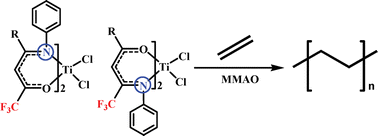A series of new titanium complexes bearing two regioisomeric trifluoromethyl-containing enaminoketonato ligands (3a–h and 6a–h), [PhN![[double bond, length as m-dash]](https://www.rsc.org/images/entities/char_e001.gif) CRCHC(CF3)O]2TiCl2 (3a, R = Me; 3b, R = n-C5H11; 3c, R = i-Pr; 3d, R = Cy; 3e, R = t-Bu; 3f, R = CH
CRCHC(CF3)O]2TiCl2 (3a, R = Me; 3b, R = n-C5H11; 3c, R = i-Pr; 3d, R = Cy; 3e, R = t-Bu; 3f, R = CH![[double bond, length as m-dash]](https://www.rsc.org/images/entities/char_e001.gif) CHPh; 3g, R = Et; 3h, R = n-C11H23) and [PhN
CHPh; 3g, R = Et; 3h, R = n-C11H23) and [PhN![[double bond, length as m-dash]](https://www.rsc.org/images/entities/char_e001.gif) C(CF3)CHC(R)O]2TiCl2 (6a, R = Ph; 6b, R = n-C5H11; 6c, R = i-Pr; 6d, R = Cy; 6e, R = t–Bu; 6f, R = CH
C(CF3)CHC(R)O]2TiCl2 (6a, R = Ph; 6b, R = n-C5H11; 6c, R = i-Pr; 6d, R = Cy; 6e, R = t–Bu; 6f, R = CH![[double bond, length as m-dash]](https://www.rsc.org/images/entities/char_e001.gif) CHPh; 6g, R = CHPh2; 6h, R = CF3) have been synthesized and characterized. X-ray crystal structures analyses suggest that complexes 3c–e and 6c–d all adopt a distorted octahedral geometry around the titanium center. Complexes 3c, 3d and 6c display a cis-configuration of the two chlorine atoms around the titanium center, while complex 6d shows a trans-configuration of the two chlorine atoms. Especially, the configurational isomers (cis and trans) of complex 3e were identified both in solution and in the solid state by NMR and X-ray analyses. With modified methylaluminoxane as a cocatalyst, all the complexes are active towards ethylene polymerization, and produce high molecular weight polymers. With the variation of the relative position of the imino group and the trifluoromethyl group of the β-enaminoketonato ligands, the polymerization behavior of the catalysts changed remarkably. It is observed that the substituent directly joined to the carbonyl in the ligands plays an important role for both the catalytic activities and the properties of the polymers produced.
CHPh; 6g, R = CHPh2; 6h, R = CF3) have been synthesized and characterized. X-ray crystal structures analyses suggest that complexes 3c–e and 6c–d all adopt a distorted octahedral geometry around the titanium center. Complexes 3c, 3d and 6c display a cis-configuration of the two chlorine atoms around the titanium center, while complex 6d shows a trans-configuration of the two chlorine atoms. Especially, the configurational isomers (cis and trans) of complex 3e were identified both in solution and in the solid state by NMR and X-ray analyses. With modified methylaluminoxane as a cocatalyst, all the complexes are active towards ethylene polymerization, and produce high molecular weight polymers. With the variation of the relative position of the imino group and the trifluoromethyl group of the β-enaminoketonato ligands, the polymerization behavior of the catalysts changed remarkably. It is observed that the substituent directly joined to the carbonyl in the ligands plays an important role for both the catalytic activities and the properties of the polymers produced.
![[double bond, length as m-dash]](https://www.rsc.org/images/entities/char_e001.gif) CRCHC(CF3)O]2TiCl2 (3a, R = Me; 3b, R = n-C5H11; 3c, R =
CRCHC(CF3)O]2TiCl2 (3a, R = Me; 3b, R = n-C5H11; 3c, R = ![[double bond, length as m-dash]](https://www.rsc.org/images/entities/char_e001.gif) CHPh; 3g, R = Et; 3h, R = n-C11H23) and [PhN
CHPh; 3g, R = Et; 3h, R = n-C11H23) and [PhN![[double bond, length as m-dash]](https://www.rsc.org/images/entities/char_e001.gif) C(CF3)CHC(R)O]2TiCl2 (6a, R = Ph; 6b, R = n-C5H11; 6c, R =
C(CF3)CHC(R)O]2TiCl2 (6a, R = Ph; 6b, R = n-C5H11; 6c, R = ![[double bond, length as m-dash]](https://www.rsc.org/images/entities/char_e001.gif) CHPh; 6g, R =
CHPh; 6g, R = 

 Please wait while we load your content...
Please wait while we load your content...